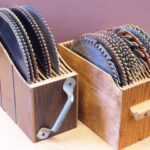What are routers used for in woodworking? Routers are essential tools that play a crucial role in shaping and creating intricate designs in wood. From edge profiling to creating strong joints, routers are versatile instruments that every woodworker should have in their arsenal. In this article, we will delve into the world of woodworking routers, exploring their various types, uses, techniques, and maintenance tips to enhance your woodworking projects.
Woodworking routers come in different types, each serving specific purposes and catering to various woodworking needs. Understanding the differences between these types of routers is essential for any woodworker looking to expand their skillset and take on more challenging projects. Additionally, router bits play an important role in achieving different cuts and designs in wood, making them an integral part of the router system.
In this comprehensive guide, we will break down the different types of routers used in woodworking, explore the various router bits and their specific uses, as well as provide step-by-step instructions on routing techniques such as edge profiling, dadoing, and grooving. Whether you’re a seasoned woodworker or just starting out in the craft, understanding how to effectively use routers can open up a world of possibilities for your woodworking projects.
Types of Routers
When it comes to woodworking, routers are an essential tool for shaping and cutting wood. There are different types of routers that woodworkers can use, each with its own specific features and advantages. Here is a comprehensive overview of the different types of routers used in woodworking:
1. Fixed Base Routers: These are the most common type of routers used in woodworking. They have a base that is set in a fixed position, making them stable and easy to control. Fixed base routers are great for edge work, grooving, and dadoing.
2. Plunge Routers: Unlike fixed base routers, plunge routers have a base that can move up and down, allowing for more flexibility and depth adjustments. This makes them ideal for tasks such as carving designs into wood or creating fluted columns.
3. Combination Routers: As the name suggests, combination routers offer the benefits of both fixed base and plunge routers. They can be used as either a fixed base or plunge router, providing versatility for different woodworking projects.
4. CNC Routers: Computer Numerical Control (CNC) routers are controlled by a computer program, allowing for precise and intricate cuts and designs on wood. These high-tech routers are commonly used in professional woodworking shops for complex projects.
5. Trim Routers: Trim routers are lightweight and compact, making them perfect for small or delicate woodworking tasks such as laminate trimming or detailed edging work.
Now that we have covered the main types of routers used in woodworking, let’s delve into the specific uses of router bits and various routing techniques to further understand how these tools contribute to the art of woodworking.
Router Bits and Their Uses
Router bits are an essential component of woodworking with routers, as they determine the type of cut that will be made. There are various types of router bits, each designed for specific woodworking tasks, including shaping, trimming, and joinery. Below is a comprehensive overview of the different types of router bits used in woodworking:
- Straight router bits: These are the most common type of router bits and are ideal for cutting straight lines or creating grooves.
- Rabbeting router bits: Used for cutting rabbets or shoulders along the edge of a workpiece, these bits are perfect for joining two pieces of wood together.
- Flush trim router bits: Ideal for trimming the edges of one material to match the profile of another material, flush trim router bits create a smooth and even surface.
- Chamfer router bits: These bits are used to create a beveled edge on a workpiece, adding decorative accents to furniture and other woodworking projects.
Once you understand the different types of router bits available, it becomes easier to select the right bit for your specific woodworking task. In addition to the types mentioned above, there are also specialized router bits for more intricate tasks such as creating raised panel doors, dovetail joints, and more.
Understanding how each type of router bit works and its specific use in woodworking projects is crucial for achieving professional results. Whether you’re working on a simple edge profiling job or a complex joinery project, selecting the right router bit can make all the difference in the quality and precision of your work. Knowing which bit to use for each task will allow you to fully unleash the capabilities of your router in woodworking.
Properly maintaining and storing your collection of router bits is also important in order to prolong their lifespan and ensure reliable performance. This includes regular cleaning, sharpening when necessary, and using protective cases to prevent damage. By taking care of your router bits, you can continue to produce high-quality woodworking projects without any unnecessary setbacks.
Routing Techniques
Routers are an essential tool in woodworking, offering a wide range of capabilities and applications. One of the key uses of routers in woodworking is edge profiling. This technique involves using a router to shape the edges of a workpiece, creating decorative profiles or beveled edges.
By using different router bits and adjusting the depth of cut, woodworkers can achieve a variety of edge profiles, adding intricacy and detail to their projects. Common types of edge profiles created with routers include chamfered edges, Roman Ogee profiles, and roundovers.
Another important function of routers in woodworking is dadoing. Dados are rectangular slots cut into the surface of a workpiece to create strong joints or to house shelves in cabinets and bookcases. Routers equipped with straight bits or spiral bits can easily cut precise dados in wood, allowing for clean and accurate joinery. By utilizing guide fences and adjustable depth stops, woodworkers can achieve consistent dado cuts across multiple workpieces.
Additionally, routers are used for grooving, which involves cutting narrow channels or grooves into the surface of the wood. Grooving is commonly employed to install splines for reinforcing joints or to create decorative fluting on table legs, molding, or panels. With the appropriate router bit and careful adjustment of cutting depth, woodworkers can efficiently produce clean and uniform grooves with routers.
Overall, routers play a crucial role in woodworking by enabling woodworkers to execute edge profiling, dadoing, and grooving with precision and efficiency.
| Routing Technique | Description |
|---|---|
| Edge Profiling | A technique used to shape the edges of a workpiece using different router bits to create decorative profiles or beveled edges. |
| Dadoing | Involves cutting rectangular slots into wood surfaces for creating strong joints or installing shelves using straight or spiral router bits. |
| Grooving | Cutting narrow channels into wood surfaces for reinforcing joints or adding decorative fluting using specific router bits. |
Creating Joints With Routers
In woodworking, routers are essential tools for creating strong and precise joints in various projects. Whether you’re working on furniture, cabinetry, or other woodworking endeavors, understanding how to use routers for joint-making is crucial. Routers can be used to create a wide range of joints, including dado joints, rabbet joints, and dovetail joints, among others.
Dado joints, which are commonly used for shelves and bookcases, are created by cutting a rectangular groove across the grain of one workpiece to receive the end of another workpiece. Routers equipped with straight bits are ideal for creating dado joints due to their ability to cut straight and clean edges.
For more intricate and decorative joints such as dovetails, routers with dovetail bits can be used. Dovetail joints are known for their strength and aesthetic appeal, making them popular in high-quality furniture and cabinet making. With the right router setup and technique, woodworkers can achieve precise and professional-looking dovetail joints.
The versatility of routers when it comes to creating various types of joints makes them indispensable in woodworking projects. Understanding how to select the appropriate router bits and master routing techniques is key to achieving seamless and durable joints that contribute to the overall quality and longevity of woodworking pieces.
| Joint Type | Router Bit |
|---|---|
| Dado Joint | Straight Bit |
| Dovetail Joint | Dovetail Bit |
Router Table Usage
Enhanced Stability and Control
Using a router table offers woodworkers enhanced stability and control compared to handheld routing. The table provides a flat, stable surface for the workpiece, allowing for smoother and more precise cuts. It also allows for greater control over the depth and angle of the cut, resulting in more accurate and consistent results. This is especially beneficial for complex or intricate woodworking projects that require high precision.
Improved Safety
A router table can also significantly improve safety when working with routers. By securing the router in place on the table, woodworkers can keep both hands on the workpiece, reducing the risk of accidental slips or injuries. Additionally, a router table often includes features such as adjustable guards and fences, which provide added protection during operation. These safety features make it an ideal option for woodworkers of all skill levels, especially those working on more advanced projects.
Ability to Handle Larger Workpieces
Another benefit of using a router table is its ability to handle larger workpieces that may be challenging to maneuver with handheld routing. The spacious surface area of the table provides ample room for working with bigger pieces of wood, making it easier to achieve consistent and uniform cuts.
This is particularly advantageous for woodworking projects that involve creating intricate designs or patterns on larger surfaces. Overall, utilizing a router table can expand a woodworker’s capabilities and open up new possibilities for more ambitious woodworking undertakings.
By incorporating a router table into their woodworking arsenal, craftsmen can take their skills to new heights by leveraging the benefits of enhanced stability and control, improved safety measures, and increased capacity for handling larger workpieces while utilizing routers.
Safety Tips
Routers are a powerful and versatile tool in woodworking, but they also require careful handling to ensure safety. Whether you are a beginner or experienced woodworker, it is essential to follow safety precautions and best practices when using routers. This section will provide an overview of the most important safety tips to keep in mind when operating a router in your woodworking projects.
First and foremost, it is crucial to wear proper personal protective equipment (PPE) when using a router. This includes safety glasses or goggles to protect your eyes from flying debris, as well as hearing protection due to the loud noise produced by the router. Additionally, wearing a dust mask is recommended to avoid inhaling sawdust particles that are created during routing.
Another important safety precaution is to always keep your hands and fingers at a safe distance from the router bit while it is in operation. It is best practice to use push blocks or push sticks to guide the workpiece through the router, ensuring that your hands are not near the cutting area.
Furthermore, never attempt to make adjustments or change the router bit while it is still plugged in – always unplug the router and wait for it to come to a complete stop before making any modifications.
Lastly, before starting any routing task, ensure that your work area is clean and free of clutter. Tripping over tools or materials can lead to accidents, so maintaining a tidy workspace contributes greatly to overall safety. By adhering to these safety tips and best practices, woodworkers can safely enjoy the benefits of using routers for various woodworking tasks.
Maintenance and Care
One of the most essential aspects of using routers in woodworking is proper maintenance and care. By taking good care of your routers, you can ensure their longevity and optimal performance, ultimately leading to high-quality results in your woodworking projects. Here are some important tips on how to properly maintain and care for routers.
Cleaning Routers Regularly
Dust, debris, and wood chips can build up in the router motor and base over time, affecting its performance. It’s essential to clean your router regularly to prevent this buildup. Use a small brush or compressed air to remove any debris from the motor vents, collet, and router base. This simple maintenance task can significantly extend the life of your router.
Lubricating Moving Parts
Another crucial aspect of maintaining routers is lubricating the moving parts. Apply a few drops of lubricating oil to the baseplate pivot points, depth adjustment mechanism, and any other moving parts as recommended by the manufacturer. This will help keep the router operating smoothly and prevent premature wear and tear on these components.
Checking and Replacing Worn Parts
Regularly inspecting your router for signs of wear is important for maintaining its performance. Check the power cord for any damage, inspect the collet for wear, and ensure that the brushes are in good condition. If any parts show signs of wear or damage, it’s important to replace them promptly to prevent further issues with the router’s operation.
By following these maintenance tips, woodworkers can ensure that their routers remain in top working condition for years to come, allowing them to continue creating high-quality woodworking projects efficiently and effectively.
Conclusion
In conclusion, routers are an essential and versatile tool in woodworking that offer a wide range of uses and applications. From edge profiling to creating joints, these powerful tools are indispensable for both beginner and experienced woodworkers. Their ability to accurately shape and trim wood makes them an invaluable addition to any workshop.
When understanding what routers are used for in woodworking, it becomes evident that the different types of routers, including handheld and table-mounted, cater to various project requirements. Additionally, the wide array of router bits available allows for precise customization and detail work in woodworking projects.
Furthermore, safety precautions and maintenance tips are crucial aspects to consider when using routers in woodworking. Adhering to safety protocols and properly maintaining routers not only ensures personal safety but also prolongs the lifespan of these tools. By following best practices, woodworkers can make the most out of their routers while minimizing potential risks.
Overall, the versatility and effectiveness of routers in woodworking make them a must-have tool for anyone looking to pursue woodworking projects. Whether it’s creating decorative edges or constructing strong joints, routers offer endless possibilities for woodworkers to unleash their creativity and achieve professional results.
Frequently Asked Questions
Do I Really Need a Router for Woodworking?
Yes, a router is an essential tool for woodworking. It is used to hollow out an area in a piece of wood, cut intricate patterns, and create smooth edges. Whether you’re shaping edges, making moldings, or cutting grooves, a router can greatly enhance the versatility and precision of your woodworking projects.
What Are the Disadvantages of a Router Woodworking?
One disadvantage of using a router for woodworking is the noise it produces. Routers can be quite loud when in use, potentially causing disturbance to those around you. Additionally, routers can be expensive, especially if you invest in high-quality models. Another disadvantage is that incorrect use of a router can result in tear-out and splintering of the wood.
What Is a Router Bit Used for in Woodwork?
A router bit is used in woodworking to cut various shapes and profiles into the wood. These bits are available in different designs and sizes to achieve specific cuts like beading, chamfering, ogee curves, and more.
They are attached to the router’s collet and rotate at high speeds to carve out or shape the wood according to the desired design or pattern. Router bits are essential for achieving precision and detail in woodworking projects.

Hi everyone! I’m a woodworker and blogger, and this is my woodworking blog. In my blog, I share tips and tricks for woodworkers of all skill levels, as well as project ideas that you can try yourself.





